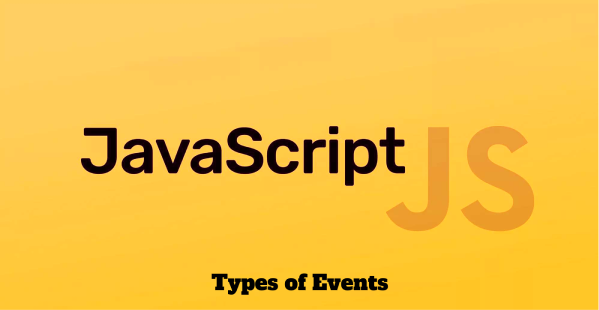Master AI & Build your First Coding Portfolio with SkillReactor | Sign Up Now
Types of Events in JavaScript

JavaScript recognizes various event types, each corresponding to different user interactions or browser actions. While there are many specific event types, they can be broadly categorized into several groups. Below are some of the major categories, along with notable examples.
Mouse Events
Mouse events are the most common and are triggered by user interactions involving a mouse or a similar pointing device.
Key events in this category include:
- click
- dblclick
- mouseover
- mouseout
click
Fired when an element is clicked.
element.addEventListener('click', function(event) { console.log('Element clicked!'); });
dblclick
Occurs on a double-click on an element.
element.addEventListener('dblclick', function(event) { console.log('Element double-clicked!'); });
mouseover
Triggered when the mouse pointer enters the element's area.
element.addEventListener('mouseover', function(event) { console.log('Mouse over element!'); });
mouseout
Fires when the mouse pointer leaves the element's area.
element.addEventListener('mouseout', function(event) { console.log('Mouse out of element!'); });
Keyboard Events
Keyboard events are essential for capturing user input from the keyboard. These include:
- keydown
- keyup
- keypress
keydown
Fired when a key is pressed down.
document.addEventListener('keydown', function(event) { console.log(`Key pressed: ${event.key}`); });
keyup
Triggered when a key is released.
document.addEventListener('keyup', function(event) { console.log(`Key released: ${event.key}`); });
keypress
Occurs when a key is pressed and released.
document.addEventListener('keypress', function(event) { console.log(`Key pressed and released: ${event.key}`); });
Form Events
Form events are crucial in managing user interactions within form elements. They include:
- submit
- change
- focus
- blur
submit
Triggered when a form is submitted.
form.addEventListener('submit', function(event) { event.preventDefault(); // to prevent form submission console.log('Form submitted!'); });
change
Occurs when the value of an input, select, or textarea element is changed.
input.addEventListener('change', function(event) { console.log('Input value changed!'); });
focus
Fired when an element receives focus.
input.addEventListener('focus', function(event) { console.log('Element focused!'); });
blur
Triggered when an element loses focus.
input.addEventListener('blur', function(event) { console.log('Element lost focus!'); });
Window Events
Window events are associated with the browser window and include:
- load
- resize
- scroll
load:
Fired when the entire page, including all dependent resources like stylesheets and images, is fully loaded.
window.addEventListener('load', function(event) { console.log('Page fully loaded!'); });
resize
Occurs when the browser window is resized.
window.addEventListener('resize', function(event) { console.log('Window resized!'); });
scroll
Triggered when scrolling occurs in the window.
window.addEventListener('scroll', function(event) { console.log('Scrolled!'); });
These examples provide a basic introduction to handling different types of events in JavaScript. For a comprehensive list of events, the Mozilla Developer Network (MDN) provides an extensive guide.